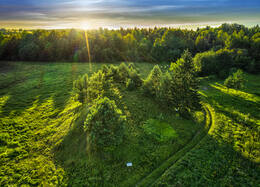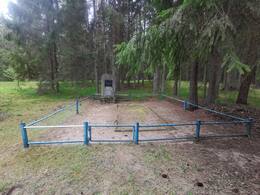Like being born a second time
In July and August 1941, the Nazi authorities in Kražiai massacred almost the entire community of the town. Marytė Gerčienė, a prisoner of the Kražiai ghetto and a collective farmer of the K. Požėla collective farm, miraculously survived this tragedy.
[...] I am from Kražiai. Before the Great Patriotic War, I lived in the town with my parents and my brother and sister. [...] But then the war began. As soon as the front passed through Kražiai, an armed police unit was organized in the town from former Lithuanian riflemen and manor men of Smetona. We simply called them - white-robed. They arrested and shot former Soviet activists, settlers, and confiscated property.
One summer day, they ordered everyone - the residents of the town - Soviet citizens of Jewish nationality - to gather at the market square. Armed white-robed men lined us up and ordered us to put down what we had. Whoever did not give - they tore it off with a vengeance. When they saw the rings on their hands, they peeled them off with their skin. After collecting everything in baskets, they ordered us to bring the things and clothes left from the house. [...], and they drove us, about 200 people, in single shirts, to the manor house of Šiukšta, and sewed yellow patches on our chests and backs. [...]
We stayed here for a week or more. And then one morning a truck with a broken roof drove up to the ghetto. The murderers threw shovels at it, ordered us to get ready. We understood what awaited us. Among us was one pregnant woman who was already suffering from the pains of childbirth. The murderers, supposedly acting "humanely", left her in a barn to give birth with 80 children, and took the parents and adults to Kūprė, from where they never returned. Thus, the sands of this forest sheltered my father, mother, brother and sister. And I was lucky enough to escape.
The children were kept in the ghetto for about a week. In front of them, the woman gave birth, and then, as her acquaintances said, she was shot near Medžiokalnis. They say her baby was thrown alive into a pit.
Bronius Kaminskas was particularly noted for his unprecedented brutality. Having escaped death, two children hid with local residents throughout the winter. Having smelled them, Br. Kaminskas took them to the cemetery and shot them.
Having escaped from the clutches of the murderers, I was always hiding [...] I walked through people. I ended up in Adomaičiai with a good, sincere peasant, Kazimieras Jankauskas [...]. And when in 1944, after three years of fear and atrocities, I saw Soviet soldiers, I felt as if I had been born a second time.
Related timeline
Related objects
Jewish Holocaust site in Kražiai (near Medžiokalnis)
At the foot of Medžiokalnis Hill, near the town of Kražiai, is the site and grave of the Kražiai Jewish massacre.
Before World War II, the town of Kražiai was home to about 1,500 people, including about 80 Jewish families – 450-500 residents of Jewish origin. In 1941, the Jews of Kražiai were isolated in a ghetto set up in the manor barn (later Jews brought from Karklėnai also entered it) and were murdered in several stages.
The Nazis actively tried to involve Lithuanians in the Holocaust: when shooting Jews, German officers sought that every policeman, rebel, partisan or white-arms soldier who arrived in the forest as a convoy member would shoot at least one of his Jewish neighbors or acquaintances. After the massacres committed in 1941, about 20 people remained from the Kražiai Jewish community, who hid in Lithuania or retreated to the depths of the USSR.
On August 2, 1941, the Nazis and their collaborators killed more than 70 children and several adult Jews near Medžiokalnis. Historian Stanislovas Buchaveckas called this massacre the "Murder of Jewish Children."
Currently, a monument stands at this location with an inscription: “On this spot on 2 August 1941, the Nazis and their collaborators murdered 71 Jews of Kražiai.” The inscription in Hebrew notes that 71 Jews of Kražiai were murdered: 6 men and women, 65 children.
Kražiai Jewish Holocaust site in Kuprė Forest
In the Kuprė forest, about 13 kilometers from the town of Kražiai, there is the site and grave of the Kražiai Jewish massacre.
Before World War II, the town of Kražiai was home to about 1,500 people, including about 80 Jewish families – 450-500 residents of Jewish origin. In the summer of 1941, the Jews of Kražiai were isolated in a ghetto set up in the manor barn.
On July 26, 1941, the mass murder of the Jews of Kražiai took place in the Kuprė forest. About 300 adults and young people were taken to the forest by trucks. During the operation, the Jews were lined up in groups and put into trucks. On the way to the massacre site, they were handed shovels - a sign that the victims would have to dig pits. The Jews dug a deep, oblong pit in the Kuprė forest. Later, they were forced to undress, and the execution took place in an organized manner: the victims were placed five at the edge of the pit, shot in two rows - the first shot in the back or chest, the second - in the head.
The killings were carried out by both members of the local TDA (National Labor Protection) unit and German soldiers and officers. The killings were delayed due to a broken-down truck and resistance in the Kražiai ghetto, when the prisoners realized that those who had been taken away were not returning. Due to these circumstances, the planned execution of 12 Soviet activists on the same day was not carried out. These individuals were later transported to Raseiniai prison and most of them were released.
German security forces confiscated valuables belonging to Jews after the massacre. The result of the operation was that almost all members of the Kražiai Jewish community over the age of 12 were exterminated.
Currently, a monument stands at the site of the Holocaust, and the site of the killing pit is enclosed by a fence.






